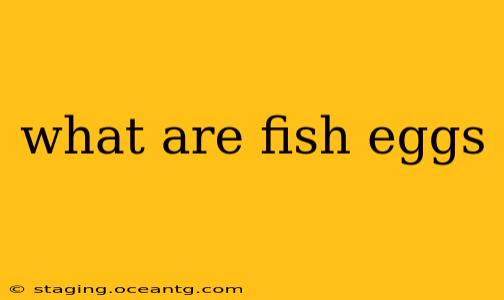Fish eggs, also known as roe, are the reproductive cells produced by female fish. These tiny, often spherical structures hold the potential for new life, and understanding their biology and variety is fascinating. This guide delves into the world of fish eggs, covering everything from their composition and development to their culinary uses and ecological significance.
What do fish eggs look like?
The appearance of fish eggs varies significantly depending on the species. Size, color, and shape are all highly variable. Some are tiny and translucent, while others are larger and brightly colored, ranging from pale yellow and orange to deep red or black. Their shape can be spherical, oval, or even slightly irregular. Many species produce adhesive eggs that stick to surfaces like plants or rocks, while others produce pelagic eggs that float freely in the water column.
What is inside a fish egg?
Inside each fish egg, you'll find a developing embryo. This embryo contains all the genetic material necessary to grow into a fish. The egg itself is a protective shell composed of various proteins and lipids, providing a vital barrier against environmental hazards. It also contains a yolk, a nutrient-rich substance that nourishes the developing embryo until it hatches.
How do fish eggs develop?
The development of fish eggs is a complex process. Once fertilized by sperm, the egg begins a series of rapid cell divisions, gradually forming organs and body structures. The duration of this process varies greatly among species, ranging from a few days to several weeks. Environmental factors such as temperature and oxygen levels significantly influence the rate of development.
What are fish eggs used for?
Fish eggs have several uses:
- Food: Many types of fish roe are considered culinary delicacies. Examples include caviar (sturgeon roe), tobiko (flying fish roe), and ikura (salmon roe). These are highly prized for their unique texture and flavor.
- Aquaculture: Fish eggs play a critical role in aquaculture, the farming of fish. They are crucial for replenishing fish stocks and ensuring a sustainable supply of seafood.
- Scientific Research: Fish eggs are valuable tools in biological research, offering insights into developmental biology, genetics, and toxicology.
Are fish eggs safe to eat?
Whether or not fish eggs are safe to eat depends on several factors, including the species of fish, their source (wild-caught or farmed), and how they have been processed and handled. Some fish, especially those from polluted waters, may contain harmful toxins in their eggs. Always source your fish eggs from reputable suppliers and follow appropriate food safety guidelines.
What is the difference between fish eggs and fish spawn?
The terms "fish eggs" and "fish spawn" are often used interchangeably, but there's a subtle distinction. Fish spawn refers to the mass of eggs released by a female fish, often along with the milt (sperm) released by a male. Fish eggs, therefore, are the individual units within the spawn.
How long do fish eggs take to hatch?
The incubation period of fish eggs varies drastically depending on the species and environmental conditions. Some fish eggs hatch within a few days, while others may take several weeks or even months. Water temperature is a crucial factor; warmer water generally leads to faster development.
How can I tell if fish eggs are fertilized?
Fertilized fish eggs typically exhibit a visible embryo or a noticeable darkening of the yolk. Unfertilized eggs often remain clear and may appear opaque or cloudy.
This comprehensive guide provides a better understanding of the fascinating world of fish eggs, covering their diverse characteristics, development, and uses. From culinary delights to scientific research and aquaculture, fish eggs are an integral part of many aspects of our lives and the ecosystem.
